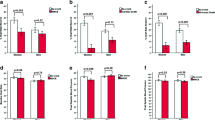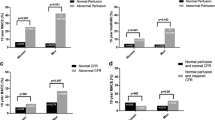Abstract
Purpose
To evaluate differences in side-effects and hemodynamic response between men and women undergoing regadenoson-stress SPECT myocardial perfusion imaging (MPI).
Methods
The initial population of the study included 858 consecutive patients who underwent regadenoson-stress MPI at our institution. These patients underwent prospective assessment and classification of regadenoson-induced side-effects in six categories and recording of heart rate (HR) and blood pressure (BP) before and after regadenoson administration. From this initial population, after adjustment with 1:1 propensity matching using gender as the dependent variable and age, BMI, diabetes mellitus, hypertension, smoking, presence of coronary artery disease, LVEF, baseline systolic and diastolic blood pressure (BP) and HR, on-going use of cardio-active medications during test, and abnormal MPI scan as independent variables, a population of 279 pairs of opposite gender was formed and studied.
Results
Compared with men, women had a significantly higher rate of any side-effect (71% vs. 58%, p = 0.002), chest pain (23% vs. 12%, p < 0.001), gastrointestinal discomfort (20% vs. 12%, p = 0.01), dizziness (12% vs. 5%, p = 0.002), and headache (20% vs. 13%, p = 0.03) and similar rates of dyspnea and other side-effects. Women demonstrated a higher median HR-response compared with men (41% (− 8, 127) vs. 34% (− 5, 106), p = 0.001) while men demonstrated a lower median systolic BP response (− 3% (− 27, 48) vs. 0% (− 36, 68), p = 0.02) compared with women.
Conclusions
Gender is independently associated with a differential response to regadenoson with regard to overall side-effects and HR-response. These observations have the potential of important management and prognostic implications respectively.





Similar content being viewed by others
References
2013 American Society of Nuclear Cardiology / MedAxiom Nuclear Survey. J Nucl Cardiol. 2014;21(Suppl 1):5–88. doi:https://doi.org/10.1007/s12350-014-9862-z.
Iskandrian AE, Bateman TM, Belardinelli L, Blackburn B, Cerqueira MD, Hendel RC, et al. Adenosine versus regadenoson comparative evaluation in myocardial perfusion imaging: results of the ADVANCE phase 3 multicenter international trial. J Nucl Cardiol. 2007;14:645–58. https://doi.org/10.1016/j.nuclcard.2007.06.114.
Mahmarian JJ, Peterson LE, Xu J, Cerqueira MD, Iskandrian AE, Bateman TM, et al. Regadenoson provides perfusion results comparable to adenosine in heterogeneous patient populations: a quantitative analysis from the ADVANCE MPI trials. J Nucl Cardiol. 2015;22:248–61. https://doi.org/10.1007/s12350-014-9981-6.
Cerqueira MD, Nguyen P, Staehr P, Underwood SR, Iskandrian AE. Effects of age, gender, obesity, and diabetes on the efficacy and safety of the selective A2A agonist regadenoson versus adenosine in myocardial perfusion imaging integrated ADVANCE-MPI trial results. JACC Cardiovasc Imaging. 2008;1:307–16. https://doi.org/10.1016/j.jcmg.2008.02.003.
Iqbal FM, Hage FG, Ahmed A, Dean PJ, Raslan S, Heo J, et al. Comparison of the prognostic value of normal regadenoson with normal adenosine myocardial perfusion imaging with propensity score matching. JACC Cardiovasc Imaging. 2012;5:1014–21. https://doi.org/10.1016/j.jcmg.2012.04.009.
Farzaneh-Far A, Shaw LK, Dunning A, Oldan JD, O’Connor CM, Borges-Neto S. Comparison of the prognostic value of regadenoson and adenosine myocardial perfusion imaging. J Nucl Cardiol. 2015;22:600–7. https://doi.org/10.1007/s12350-015-0155-y.
Mahmarian JJ, Cerqueira MD, Iskandrian AE, Bateman TM, Thomas GS, Hendel RC, et al. Regadenoson induces comparable left ventricular perfusion defects as adenosine: a quantitative analysis from the ADVANCE MPI 2 trial. JACC Cardiovasc Imaging. 2009;2:959–68. https://doi.org/10.1016/j.jcmg.2009.04.011.
Hussain N, Chaudhry W, Ahlberg AW, Amara RS, Elfar A, Parker MW, et al. An assessment of the safety, hemodynamic response, and diagnostic accuracy of commonly used vasodilator stressors in patients with severe aortic stenosis. J Nucl Cardiol. 2017;24:1200–13. https://doi.org/10.1007/s12350-016-0427-1.
Gupta A, Bajaj NS. Regadenoson use for stress myocardial perfusion imaging in advance chronic kidney disease and dialysis: safe, effective, and efficient. J Nucl Cardiol. 2018;25:150–2. https://doi.org/10.1007/s12350-017-1038-1.
Golzar Y, Doukky R. Regadenoson use in patients with chronic obstructive pulmonary disease: the state of current knowledge. Int J Chron Obstruct Pulmon Dis. 2014;9:129–37. https://doi.org/10.2147/COPD.S56879.
Rai M, Ahlberg AW, Marwell J, Chaudhary W, Savino JA 3rd, Alter EL, et al. Safety of vasodilator stress myocardial perfusion imaging in patients with elevated cardiac biomarkers. J Nucl Cardiol. 2017;24:724–34. https://doi.org/10.1007/s12350-016-0448-9.
Brinkert M, Reyes E, Walker S, Latus K, Maenhout A, Mizumoto R, et al. Regadenoson in Europe: first-year experience of regadenoson stress combined with submaximal exercise in patients undergoing myocardial perfusion scintigraphy. Eur J Nucl Med Mol Imaging. 2014;41:511–21. https://doi.org/10.1007/s00259-013-2619-0.
Verberne HJ, Acampa W, Anagnostopoulos C, Ballinger J, Bengel F, De Bondt P, et al. EANM procedural guidelines for radionuclide myocardial perfusion imaging with SPECT and SPECT/CT: 2015 revision. Eur J Nucl Med Mol Imaging. 2015;42:1929–40. https://doi.org/10.1007/s00259-015-3139-x.
Andrikopoulou E, Hage FG. Heart rate response to regadenoson: making the case for its value in clinical practice. J Nucl Cardiol. 2016;23:575–80. https://doi.org/10.1007/s12350-015-0269-2.
Salgado-Garcia C, Jimenez-Heffernan A, Lopez-Martin J, Molina-Mora M, Aroui T, Sanchez de Mora E, et al. Influence of body mass index and type of low-level exercise on the side effect profile of regadenoson. Eur J Nucl Med Mol Imaging. 2017;44:1906–14. https://doi.org/10.1007/s00259-017-3717-1.
Farris GR, Hage FG, Kumar V, Iskandrian AE. Indirect evidence of sympathetic stimulation by regadenoson. J Nucl Cardiol. 2018. https://doi.org/10.1007/s12350-018-1331-7.
Doyle SE, Breslin FJ, Rieger JM, Beauglehole A, Lynch WJ. Time and sex-dependent effects of an adenosine A2A/A1 receptor antagonist on motivation to self-administer cocaine in rats. Pharmacol Biochem Behav. 2012;102:257–63. https://doi.org/10.1016/j.pbb.2012.05.001.
Bazzett TJ, Becker JB. Sex differences in the rapid and acute effects of estrogen on striatal D2 dopamine receptor binding. Brain Res. 1994;637:163–72.
Pothineni NV, Shirazi LF, Mehta JL. Gender differences in autonomic control of the cardiovascular system. Curr Pharm Des. 2016;22:3829–34.
Taqueti VR, Dorbala S, Wolinsky D, Abbott B, Heller GV, Bateman TM, et al. Myocardial perfusion imaging in women for the evaluation of stable ischemic heart disease-state-of-the-evidence and clinical recommendations. J Nucl Cardiol. 2017;24:1402–26. https://doi.org/10.1007/s12350-017-0926-8.
Doukky R, Morales Demori R, Jain S, Kiriakos R, Mwansa V, Calvin JE. Attenuation of the side effect profile of regadenoson: a randomized double-blinded placebo-controlled study with aminophylline in patients undergoing myocardial perfusion imaging. “The ASSUAGE trial”. J Nucl Cardiol. 2012;19:448–57. https://doi.org/10.1007/s12350-012-9533-x.
Thomas GS, Thompson RC, Miyamoto MI, Ip TK, Rice DL, Milikien D, et al. The RegEx trial: a randomized, double-blind, placebo- and active-controlled pilot study combining regadenoson, a selective A(2A) adenosine agonist, with low-level exercise, in patients undergoing myocardial perfusion imaging. J Nucl Cardiol. 2009;16:63–72. https://doi.org/10.1007/s12350-008-9001-9.
Davila CD, Udelson JE. Trials and tribulations of assessing new imaging protocols: combining vasodilator stress with exercise. JACC Cardiovasc Imaging. 2018;11:494–504. https://doi.org/10.1016/j.jcmg.2017.12.005.
Rangel MO, Demori RM, Doukky R. Age and gender as predictors of benefit from aminophylline administration in patients undergoing regadenoson stress myocardial perfusion imaging: a substudy of the ASSUAGE trial. Am J Ther. 2013;20:622–9. https://doi.org/10.1097/01.mjt.0000434986.92593.8b.
Uzendu AI, Iskandrian A, Hage FG. The heart rate response to regadenoson in patients with atrial fibrillation. J Nucl Cardiol. 2018;25:1012–6. https://doi.org/10.1007/s12350-017-1051-4.
Hage FG, Dean P, Iqbal F, Heo J, Iskandrian AE. A blunted heart rate response to regadenoson is an independent prognostic indicator in patients undergoing myocardial perfusion imaging. J Nucl Cardiol. 2011;18:1086–94. https://doi.org/10.1007/s12350-011-9429-1.
Andrikopoulou E, Hage FG. Adverse effects associated with regadenoson myocardial perfusion imaging. J Nucl Cardiol. 2018;25:1724–31. https://doi.org/10.1007/s12350-018-1218-7.
Author information
Authors and Affiliations
Corresponding author
Ethics declarations
Conflict of interest
The authors declare that they have no conflict of interest.
Ethical approval
All procedures performed in the present study were in accordance with the ethical standards of the institutional research committee and with the 1964 Helsinki declaration and its later amendments.
Informed consent
Informed consent was obtained from all individual participants included in the study.
Additional information
Publisher’s note
Springer Nature remains neutral with regard to jurisdictional claims in published maps and institutional affiliations.
This article is part of the Topical Collection on Cardiology
Rights and permissions
About this article
Cite this article
Katsikis, A., Kyrozi, E., Manira, V. et al. Gender-related differences in side-effects and hemodynamic response to regadenoson in patients undergoing SPECT myocardial perfusion imaging. Eur J Nucl Med Mol Imaging 46, 2590–2600 (2019). https://doi.org/10.1007/s00259-019-04463-9
Received:
Accepted:
Published:
Issue Date:
DOI: https://doi.org/10.1007/s00259-019-04463-9




